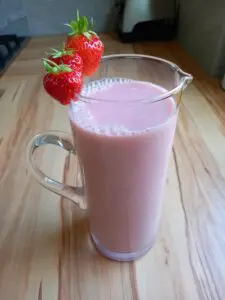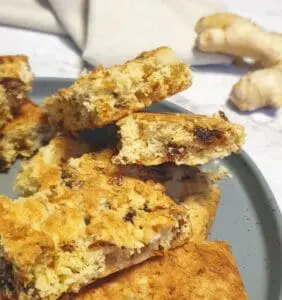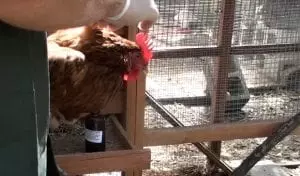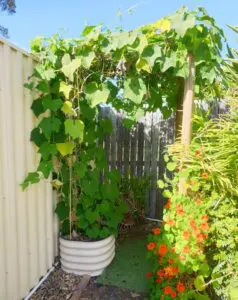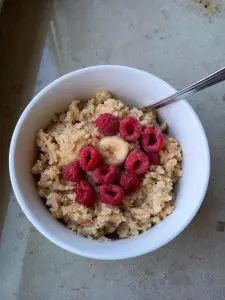Fruit trees are a long-term step towards food security. So it makes sense that you’ll want to look after them as best you can. They can take several years to become productive though, during which time you’ll invest a lot of effort, care and energy. Painting the trunks of fruit trees is an ages-old practice that is done for their protection. If you’ve never heard of it, it’s a quick and easy extra way to protect your fruit trees which costs very little.
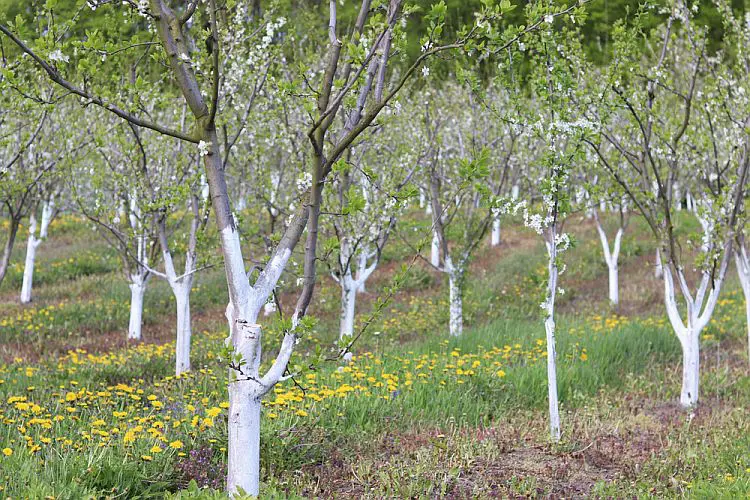
Why Paint Tree Trunks?
Painting, or whitewashing, tree trunks has been around for over a hundred years, and is still widely practised by horticulturalists and many professional orchardists. It can benefit trees grown in any climate.
When you prune a fruit tree, the trunk and branches become exposed to direct sun, so painting the bark will protect it from sunburn and splitting bark. The paint will act as a reflector, and prevent thin bark from drying out & cracking in the harsh sun. The paint also fills any existing small cracks, thus preventing harmful bugs like beetles, moth larvae and horntails getting in. For some there is an aesthetic reason too- they just think it makes the trees look more attractive.
But this is not just a technique for hot climates. In cool climates during cold, clear weather, tree bark is exposed to warm daytime temperatures and direct sunlight. The warmth coaxes the light-exposed tissues out of dormancy, causing them to need moisture. At the same time, the cold temperatures around the shaded side of the tree, including the roots, remain too cold for those parts of the tree to break dormancy. These cooler, dormant tissues are unable to take up the moisture needed by the active tissues. As a result, tissue may be dead on sun-exposed areas by the time spring arrives. These areas are more susceptible to entry by boring insects and fungal diseases.
Sunburn on young trees can seriously affect growth. In most cases sunburn causes a slow decline. The leaves go yellow and slowly dry out, and the canopy will look generally unhealthy. The trunks of affected trees can’t develop normally and they tend to look leggy.

When you paint the tree trunk with white latex paint (diluted to half strength with water), you reduce the warming of the trunk during the day. White is used because it is not harmful to the tree and is effective at reflecting sunlight to moderate changes in the temperature of the trunk.
How to Paint Your Fruit Trees
Painting the trunks of your fruit trees is as easy as it sounds- you literally just paint the bark. You’ll need to apply two coats, with the first coat thinner than the second. You can make the first coat thinner by diluting it 50:50 with water. Let the first coat dry before applying the second. Stir the mixture frequently as you paint.
Dig some soil from around the base before you start, as the paint should ideally start from 1″ below the soil line. Professional orchardists suggest painting 2 or 3 feet up the trunk, depending on your climate and the amount of exposed bark. This is because sunburn almost always occurs on the lower portion of the trunk.

On young fruit trees, sunburn damage almost always occurs low on the trunk just above ground level. This is where the suns radiation and reflection off the ground concentrates to cause the most damage. Where the sun damages the tree the tissue becomes brown and slightly sunken. While young trees can be painted, you need to wait until they are at least two years old.
What Do I Paint With?
To whitewash a tree trunk in your home garden or orchard, you can use basic acrylic white paint. Simply mix 50 percent interior white latex paint with 50 percent water. Don’t use oil-based paint, as it is toxic to the trunk and will do more harm than good.
You can make your own traditional whitewash at home using hydrated lime, water and oil. This organic preparation is based on hydrated lime, also called known as slake or builder’s lime. Hydrated lime is readily available from hardware stores and building suppliers, but is caustic, so be careful when handling it. Adding oil helps the wash to stick. Linseed oil is the traditional choice, or you can use a garden-specific product like eco-oil.

Alternatives to whitewashing include wrapping the trunks with paper, plastic, tree guards or cloth tape. You can make your own tree guards with lengths of white corrugated drain pipe, split lengthwise and slipped around the trunk. These materials have the added benefit of protecting the bark from larger pests like rodents and deer.
Which Trees Suit Trunk Painting?
Almost all fruit trees can be painted, but some will benefit from it more than others. White washing will aid trees such as apples, pears, cherries, and plums. These trees grow their branches upright, so when they’re young the slim branches & trunk are very exposed. Another type of tree that is extremely sensitive to the sun in general and often needs its trunk painted is avocados. You shouldn’t need to paint your tree trunks every year- once every two or three years should be sufficient.
So why not give whitewashing a go! It’s a quick and easy job which will protect your fruit trees. It’ll give them a head start when they’re young plus help them well into the future!

